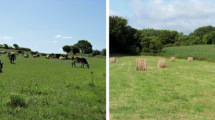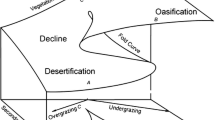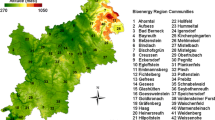Abstract
The production of pasture in Ethiopia was simulated by means of a dynamic model. Most of the country is characterized by a tropical monsoon climate with mild temperatures and precipitation mainly concentrated in the June–September period (main rainy season). The production model is driven by solar radiation and takes into account limitations due to relocation, maintenance respiration, conversion to final dry matter, temperature, water stress, and nutrients availability. The model also considers the senescence of grassland which strongly limits the nutritional value of grasses for livestock. The simulation for the 1982–2009 period, performed on gridded daily time series of rainfall and maximum and minimum temperature with a resolution of 0.5°, provided results comparable with values reported in literature. Yearly mean yield in Ethiopia ranged between 1.8 metric ton per hectare (t ha-1) (2002) and 2.6 t ha−1 (1989) of dry matter with values above 2.5 t ha-1 attained in 1983, 1985, 1989, and 2008. The Ethiopian territory has been subdivided in 1494 cells and a frequency distribution of the per-cell yearly mean pasture production has been obtained. This distribution ranges from 0 to 7 t ha-1 and it shows a right skewed distribution and a modal class between 1.5–2 t ha-1. Simulation carried out on long time series for this peculiar tropical environment give rise to as lot of results relevant by the agroecological point of view on space variability of pasture production, main limiting factors (solar radiation, precipitation, temperature), and relevant meteo-climatic cycles affecting pasture production (seasonal and inter yearly variability, ENSO). These results are useful to establish an agro-ecological zoning of the Ethiopian territory.





Similar content being viewed by others
References
Ali I, Cawkwell F, Dwyer E, Barrett B, Green S (2016) Satellite remote sensing of grasslands: from observation to management. Journal of Plant Ecology 9(6):649–671. https://doi.org/10.1093/jpe/rtw005
Allen RG, Pereira LS, Raes D, Smith M (1998) Crop evapotranspiration—guidelines for computing crop water requirements—FAO irrigation and drainage paper 56. FAO - Food and Agriculture Organization of the United Nations, Rome
Amede T, Mengistu S, Roothaert R (2005) Intensification of livestock feed production in Ethiopian highlands potential and experiences of the African highlands initiative, presented at the 19th EVA annual conference, 8 June 2005, ECA, Addis Ababa 8available at https://cgspace.cgiar.org/handle/10568/76954 - web site visited 10 January 2017)
Ayres JF (1993) The application of Australian tropical pasture technology to Asai and pacific—review. AJAS 6(2):169–186
Bagella S, Roggero PP (2004) Integrating phytosociological and agronomic analysis to support the sustainable management of Mediterranean grasslands. Fitosociologia 41(1 - Suppl. 1):101–107
Barrios S (2007) Soil biota, ecosystem services and land productivity. Ecol Econ 64(2007):269–285
Ben Touhami H, Lardy R, Barra V, Bellocchi G (2013) Screening parameters in the pasture simulation model using the Morris method. Ecol Model 266:42–57
Ben Touhami H, Bellocchi G (2015) Bayesian calibration of the pasture simulation model (PaSim) to simulate European grasslands under water stress. Eco Inform 30:356–364. https://doi.org/10.1016/j.ecoinf.2015.09.009
Boonman JG (1993) East Africa’s grasses and foddes: their ecology and husbandry. Tasks for vegetation science 29, In: Tasks for vegetation science (Netherlands), v. 29 / Dordrecht (Netherlands), Kluwer , 1993 , 343 p
Boote KJ, Jones JW, White JW, Asseng S, Lizaso JI (2013) Putting mechanisms into crop production models. Plant Cell Environ 36:1658–1672. https://doi.org/10.1111/pce.12119
Boughey AS (1968) Ecology of populations. Macmillan Company, London 133 pp
Brouwer R, de Wit CT (1969) A simulation model of plant growth with special attention to root growth and its consequences. In: Whittington WJ (ed) proceedings 15th easter School in Agricultural Sciences. University of Nottingham, Butterworths, London, pp 224–244
Clark DB, Mercado LM, Sitch S, Jones CD, Gedney N, Best MJ, Pryor M, Rooney GG, Essery RLH, Blyth E, Boucher O, Harding RJ, Cox PM (2011) The Joint UK Land Environment Simulator (JULES), model description – Part 2: Carbon fluxes and vegetation dynamics. Geosci. Model Dev. 4:701–722. https://doi.org/10.5194/gmd-4-701-2011
Cola G, Mariani L, Salinari F, Civardi S, Bernizzoni M, Gatti M, Poni S (2014) Description and testing of a weather-based model for predicting phenology, canopy development and source–sink balance in vitis vinifera L. cv. Barbera. Agric For Meteorol 184:117–136
Denison RF, Loomis RS (1989) An Integrative Physiological Model of Alfalfa Growth and Development Univ. Calif. Div. Agric. Natural Resources, Publ. 1926,73 pp
Dunne T, Western D, Dietrich WE (2011) Effects of cattle trampling on vegetation, infiltration, and erosion in a tropical rangeland. J Arid Environ 75(1):58–69
Dusseldorp M, Sauter A (2011) Possible contributions of research to solve the world food problem—approaches, strategies, implementation. Office of Technology Assessment at the German Bundestag, 24 pp. (available at http://www.tab-beim-bundestag.de/en/pdf/publications/summarys/TAB-Arbeitsbericht-ab142_Z.pdf - web site visited 14 January 2015)
El-Fandy MG, Ashour ZH, Taiel SMM (1994) Time series models adoptable for forecasting Nile floods and Ethiopian rainfalls. Bull Am Meteorol Soc 75(1):83–94
FAO (2011) Save and grow—a policymaker’s guide to the sustainable intensification of smallholder crop production, 104 pp
Gadisch G, Schunke RM, Giller KE (1994) Nitrogen cycling in a pure grass pasture and grass-legume mixture on a red latsol in Brazil. Trop Grassl 28:43–52
Graux AI, Bellocchi G, Lardy R, Soussana JF (2013) Ensemble modelling of climate change risks and opportunities for managed grasslands in France. Agric For Meteorol 170:114–131
Grieser J, Gommes R, Cofield S, Bernardi M (2006) World maps of climatological net primary production of biomass, NPP, http://www.fao.org/nr/climpag/globgrids/npp_en.asp (web site accessed the 29th October 2016)
van Laar HH, Goudriaan J (1997) SUCROS97: simulation of crop growth for potential and water-limited production situations as applied to spring wheat, DLO. Wageningen, Research Institute for Agrobiology and soil fertility 52 pp
Harper AB, Cox PM, Friedlingstein P, Wiltshire AJ, Jones CD, Sitch S, Mercado LM, Groenendijk M, Robertson E, Kattge J, Bönisch G, Atkin OK, Bahn M, Cornelissen J, Niinemets U, Onipchenko V, Peñuelas J, Poorter L, Reich PB, Soudzilovskaia NA, Bodegom PV (2016) Improved representation of plant functional types and physiology in the Joint UK Land Environment Simulator (JULES v4.2) using plant trait information. Geoscientific Model Development 9:2415–2440. https://doi.org/10.5194/gmd-9-2415-2016
Humlum O, Stordahl K, Solheim J (2013) The phase relation between atmospheric carbon dioxide and global temperature. Global and Planetary Change 100:51–69
Hurni H (1998) Agroecological belts of Ethiopia—explanatory notes on three maps at a scale of 1:1,000,000, Soil Conservation Research Programme, Soil Conservation Research Programme, Centre for Development and Environment University of Bern - Switzerland in association with The Ministry of Agriculture of Ethiopia, 31 pp
International Livestock Centre for Africa (1975) Evaluation and mapping of tropical African rangelands, proceedings of the seminar held in Bamako - Mali - 3-8 March 1975. Document available at http://www.fao.org/wairdocs/ilri/x5543b/x5543b00.htm#Contents (web site accessed the 26 August 2016)
IPCC (2013) Climate Change 2013: The Physical Science Basis. Contribution of Working Group I to the Fifth Assessment Report of the Intergovernmental Panel on Climate Change [Stocker TF, Qin D, Plattner G-K, Tignor M, Allen SK, Boschung J, Nauels A, Xia Y, Bex V, Midgley PM (eds.)]. Cambridge University Press, Cambridge, United Kingdom and New York, NY, USA, 1535 pp, https://doi.org/10.1017/CBO9781107415324
Karalis JD (1989) Characteristics of direct photosynthetically active radiation. Agric. Forest Meteor. 48:225–234
Kebede G, Assefa G, Feyissa F, Mengistu A (2016) Management and improvement practices of natural pasture in the mid and high altitude areas of Ethiopia. Int J Livest Res 6(5):1–14
Kinyamario JI (2015) NPP Grassland: Nairobi, Kenya, 1984–1994, R1. Data set. Available on-line [http://daac.ornl.gov] from Oak Ridge National Laboratory Distributed Active Archive Center, Oak Ridge, Tennessee, USA. doi: https://doi.org/10.3334/ORNLDAAC/151
Kipling et al (2016a) Modelling European ruminant production systems: facing the challenges of climate change. Agric Syst 147:24–37. https://doi.org/10.1016/j.agsy.2016.05.007
Kipling et al (2016b) Key challenges and priorities for modelling European grasslands under climate change. Sci Total Environ 566–567:851–864. https://doi.org/10.1016/j.scitotenv.2016.05.144
Lemaire G, Hodgson J, Moraes A (2000) Grassland ecophysiology and grazing ecology, CABI Publishing, 429 pp
Lieth H (1972) Über die Primärproduktion der Pflanzendecke der Erde. Z. Angew. Bot 46:1–37
Luo W, Jiang Y, Lü X, Wang X, Li M, Bai E, Han X, Xu Z (2013) Patterns of plant biomass allocation in temperate grasslands across a 2500-km transect in Northern China. PLOS ONE 8(8):e71749. https://doi.org/10.1371/journal.pone.0071749
Ma S, Lardy R, Graux AI, Touhami HB, Klumpp K (2015) Regional-scale analysis of carbon and water cycles on managed grassland systems. Environ Model Softw 72:356–371. https://doi.org/10.1016/j.envsoft.2015.03.007
Mariani L, Maugeri M (2002) Alcune considerazioni di tipo agroclimatico su serie storiche della Sicilia Orientale. In: Atti di AIAM 2002. Acireale, p. 84-95 (In Italian)
Mariani L, Bocchi S, Boschetti M, Gusmeroli F, Casarini R (2005a) Stima della produzione dei pascoli alpini con tecniche modellistiche e di remote sensing. In: 15° convegno della Società Italiana di Agronomia - Quaderno degli Abstract. Foggia, 20-22 settembre 2005, p. 96-97 (In Italian)
Mariani L, Parisi S, Gilioli G (2013) Simulation of grazed grassland productivity in Ethiopian Highlands, Ital J Agrometeoro, Proceedings of Aiam 2013, Florence, 4–6 June, 29–30
Mariani L, Bocchi S, Boschetti M, Gusmeroli F, Casarini R (2005b) Estimate of alpine pastures production with modeling techniques and remote sensing. Proceedings of the 15th congress of the Italian Society for Agronomy, Foggia, 20-22 September 2005, 96–97 (in Italian)
Mengistu A (2006) Country pasture/forage resource profiles—Ethiopia, FAO, http://www.fao.org/ag/agp/agpc/doc/counprof/ethiopia/ethiopia.htm (web site visited the 1 October 2016)
Mwendera EJ, Saleem Mohamed MA, Tadesse A (1999) Biomass requirements from natural pastures for livestock grazing and soil protection in the eastern African highlands. Report
Null J (2016) El Niño and La Niña years and intensities based on Oceanic Niño Index (ONI), http://ggweather.com/enso/oni.htm (website visited on 29 october 2016)
Oerke EC (2006) Crop losses to pests. J Agric Sci 144:31–43
O'Mara FP (2012) The role of grasslands in food security and climate change. Ann Bot 110:1263–1270
OpenAfrica (2016) Ethiopia’s Administrative Regions, https://africaopendata.org/dataset/ethiopia-shapefiles/resource/47564350-00ed-4863-8a96-98fba25d24d5 (web site visited the 4 November 2016)
Ospina S, Rusch GM, Pezo D, Casanoves F, Sinclair FL (2012) More stable productivity of semi natural grasslands than sown pastures in a seasonally dry climate. PLoS One 7(5):e35555
Pembleton KG, Cullen BR, Rawnsley RP, Harrison MT (2016) Modelling the resilience of forage crop production to future climate change in the dairy regions of Southeastern Australia using APSIM. J Agric Sci 154(7):1131–1152. https://doi.org/10.1017/S0021859615001185
Penning de Vries FWT, Jansen DM, ten Berge HFM, Bakema A, eds (1989) Simulation of Ecophysiological Processes of Growth in Several Annual Crops. IRRI, Los Baños, and Pudoc, Wageningen
Ramesh KV, Goswami P (2014) Assessing reliability of regional climate projections: the case of Indian monsoon. Sci Rep 4:4071. https://doi.org/10.1038/srep04071
Refsgaard JC, Henriksen HJ (2004) Modelling guidelines––terminology and guiding principles. Adv Water Resour 27:71–82
Reich PB, Tilman D, Naeem S, Ellsworth DS, Knops J, Craine J, Wedin D, Trost J (2004) Species and functional group diversity independently influence biomass accumulation and its response to CO 2 and N. Proceedings National Academy of Sciences, USA 101:10101–10106
Reicosky D, Winkelman L, Baker J, Baker D (1989) Accuracy of hourly air temperatures calculated from daily minima and maxima. Agr Forest Meteorol. 46(3):193–209
Riedo M, Grub A, Rosset M, Fuhrer J (1998) A pasture simulation model for dry matter production and fluxes of carbon, nitrogen, water and energy. Ecol Model 105:41–183
Ripley BS, Abraham TI, Osborne CP (2008) Consequences of C4 photosynthesis for the partitioning of growth: a test using C3 and C4 subspecies of Alloteropsis semialata under nitrogen limitation. Journal of Experimental Botany 59:1705–1714
Romera et al (2010) Improving the McCall herbage growth model. NZ J Agric Res 52(4):477–494
Rotz, CA, Corson MS, Chianese DS, Montes F, Hafner SD, Coiner CU (2013) The integrated farm system model reference manual, Version 4.0 https://www.ars.usda.gov/SP2UserFiles/Place/19020500/Reference%20Manual.pdf (web site visited the 31 July 2015)
Sándor R, Barcza Z, Hidy D, Lellei-Kovács E (2016). Modelling of grassland fluxes in Europe: evaluation of two biogeochemical models, agriculture, ecosystems & environment, Volume 215, 1 January 2016, Pages 1–19 doi: https://doi.org/10.1016/j.agee.2015.09.0010
Schoneveld GC (2015) The challenge of governing Africa’s new agricultural investment landscapes: an analysis of policy arrangements and sustainability outcomes in Ethiopia and Nigeria. Forests 2015(6):88–115. https://doi.org/10.3390/f6010088
Slevin D, Tett S, Williams M (2016) Multi-site evaluation of the JULES land surface model using global and local data. Geosci Model Dev 8:295–316. https://doi.org/10.5194/gmd-8-295-2015
Smith MD, Knapp AK, Collins SL (2009) A framework for assessing ecosystem dynamics in response to chronic resource alterations induced by global change. Ecology 90:3279–3289
Snow VO et al (2015) The challenges—and some solutions—to process-based modelling of grazed agricultural systems. Environ Model Softw 62:420–436. https://doi.org/10.1016/j.envsoft.2014.03.009
Taddese G, Peden D, Abiye A, Wagnew A (2003) Effect of manure on grazing lands in Ethiopia, East African Highlands. Mt Res Dev 23(2):156–160
Taiz L, Zeiger E, Moller I M, Murphy A (2014) Plant physiology and development, sixth edn Sinauer Associates, Inc., 760p
Thornley JHM (1998) Grassland dynamics. An ecosystem simulation model. CAB International, Wallingford 256p
Tilahun H, Schmidt E (2012) Spatial analysis of livestock production patterns in Ethiopia, Ethiopia Strategy Support Program II (ESSP II) working paper 44, International Food Policy Research Institute, 28 pp (freely available at http://www.ifpri.org/sites/default/files/publications/esspwp44.pdf - web site accessed 14 January 2015)
van Ittersum MK, Leffelaar PA, Van Keulen H, Kropff MJ, Bastiaans L, Goudriaan J (2003) On approaches and applications of the Wageningen crop models. Europ J Agron 18:201–234
van Keulen H, Wolf J (1986) Modelling of agricultural production: weather, soils and crops. Simulation Monographs, Pudoc, Wageningen
van Laar HH, Goudriaan J, van Keulen H (1997) SUCROS97: simulation of crop growth for potential and water-limited production situations as applied to spring wheat, DLO. Wageningen, Research Institute for agrobiology and soil fertility 52 pp
Vital JA, Gaurut M, Lardy R, Viovy N (2013) High-performance computing for climate change impact studies with the pasture simulation model. Comput Electron Agric 98:131–135. https://doi.org/10.1016/j.compag.2013.08.004
Wagena MB et al (2016) Climate change in the Blue Nile Basin Ethiopia: implications for water resources and sediment transport. Clim. Change 139:229–243. https://doi.org/10.1007/s10584-016-1785-z
Whish G, Cowley RA, Pahl LI, Scanlan JC, Mac leod ND (2014) Impacts of projected climate change on pasture growth and safe carrying capacities for 3 extensive grazing land regions in northern Australia, 2014. Trop Grassl Forrajes Trop 2:151–153
Woodward SJR (1998) Quantifying different causes of leaf and tiller death in grazed perennial ryegrass swards. New Zealand J Agric Res 41:149–159
Wu Z, Dijkstra P, Koch GW, Hungate BA (2012) Biogeochemical and ecological feedbacks in grassland responses to warming. Nat Clim Chang 2:458–461
Xu Z, Jiang Y, Jia B, Zhou G (2016) Elevated-CO2 response of stomata and its dependence on environmental factors. Front Plant Sci 7:657
Zewdu T (2005) Identification of indigenous pasture and the effect of time of harvesting and nitrogen fertilizer in the northwestern Ethiopian highlands. TropSci 45:28–32
Acknowledgments
The research presented in this paper has been possible; thanks to the CNR-IMATI (Milan) Institute that supported us financially in acquiring ETHIOMET meteorological dataset.
We thank also Dr. Sara Pasquali of CNR-IMATI who held an important review process to our manuscript.
Author information
Authors and Affiliations
Corresponding author
Electronic supplementary material
Fig. S0
The nine ethnically based and politically autonomous regional states and the two chartered cities of Addis Ababa and Dire Dawa. (JPEG 19 kb)
Fig. S1
Flowchart of the model. (JPEG 48 kb)
Fig. S2
Yearly average precipitation for the period 1982–2009 (mm) (JPEG 71 kb)
Fig. S3
Yearly average temperature 1982–2009 (°C) (JPEG 110 kb)
Fig. S4
Percent of yearly average precipitation that falls during the Kiremt period (June–September). (JPEG 433 kb)
Fig. S5
Monthly mean production for period 1982–2009 (t/ha of dry matter) (JPEG 31 kb)
Fig. S6
Coefficient of variation of the yearly production for period 1982–2009 (%) (JPEG 487 kb)
ESM 1
(DOCX 54 kb)
Rights and permissions
About this article
Cite this article
Parisi, S.G., Cola, G., Gilioli, G. et al. Modeling and improving Ethiopian pasture systems. Int J Biometeorol 62, 883–895 (2018). https://doi.org/10.1007/s00484-017-1492-0
Received:
Revised:
Accepted:
Published:
Issue Date:
DOI: https://doi.org/10.1007/s00484-017-1492-0




